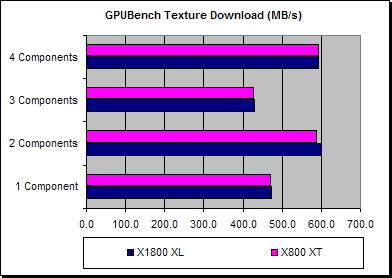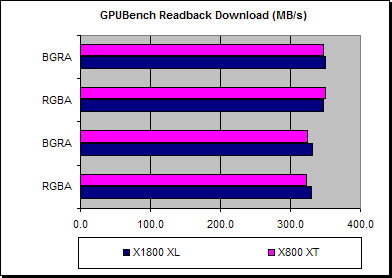Host Interface Performance
One element that ATI state they have improved on this new generation of graphics chips is that of the PCI Express interface, such that there should be a faster performance between the graphics board and its host. We'll put this to the test using a few cases from the Stanford University general purpose graphics benchmark GPUBench.
Graphics boards are obviously tasked with rendering games in the majority of cases, and a common scenario for the host interface having an effect of rendering performance is when texture data is addressed from system RAM, hence it is drawn over the host interface. GPUBench's Texture Download benchmark tests the performance when reading textures downstream, from CPU to graphics.

| GPUBench Upload (MB/s) | 1 Component | 2 Components | 3 Components | 4 Components |
| X1800 XL | 473.0 | 601.5 | 428.9 | 592.0 |
| X800 XT | 469.8 | 587.7 | 427.1 | 593.2 |
| 1 Component | 2 Components | 3 Components | 4 Components | |
| X1800 XL % Diff | 0.7% | 2.3% | 0.4% | -0.2% |
Generally speaking there appears to be no variance in the performance for the X1800 XL in relation to the ATI's first high end PCI Express entrant, the X800 XT, with the performance staying within a few percent of one another.
The "Readback" test from GPUBench also looks at the upstream performance of the host interface by reading data back from the graphics board into system memory.

| GPUBench Readback (MB/s) | RGBA | BGRA | RGBA | BGRA |
| X1800 XL | 329.3 | 331.0 | 347.5 | 349.4 |
| X800 XT | 322.9 | 324.2 | 349.5 | 347.4 |
| 640x480 | 800x600 | 1024x768 | 1280x1024 | |
| X1800 XL % Diff | 2.0% | 2.1% | -0.6% | 0.6% |
As with the texture download test the performances between the two generations of boards are again very similar.
The Serious Magic Image Download test performs a somewhat similar test to GPUBench's Readback test, however the Serious Magic test is based on DirectX, while GPUBench uses OpenGL.

| Serious Magic Image Download (MB/s) | 640x480 | 800x600 | 1024x768 | 1280x1024 | 1600x1200 |
| X1800 XL | 921 | 910 | 875 | 840 | 808 |
| X800 XT | 690 | 708 | 708 | 723 | 730 |
| 640x480 | 800x600 | 1024x768 | 1280x1024 | 1600x1200 | |
| X1800 XL % Diff | 33.5% | 28.5% | 23.6% | 16.2% | 10.7% |
Using Serious Magic we can actually see some improvements on the X1800 board in relation to ATI's prior generation, with performance differences up to 34% at low resolution, but that scaling down to 11% at higher resolutions. this would appear to confirm that the interface performance has improved, but in this instance the state of ATI's OpenGL driver is hindering things and only under DirectX are the differences showing on this current set of drivers.
